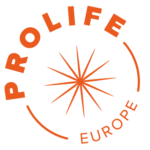THE
beginning
of LIFE
From two to one – life begins with the so-called fertilisation.
“The human being does not develop into a human being, but as a human being. He does not become human, but is human… in every phase of his development, from fertilisation onwards.“
Prof. Dr. med Erich Blechschmidt, Embryologist
A selection of the most important
MILESTONES OF prenatal development
With fertilisation, a new human life has begun. The unique DNA created in the process has already determined all the characteristics of the human being: gender, blood group, eye and hair colour and numerous other traits.
The fertilised egg nests in the uterus. Here the human being grows for the next nine months. Its cells organise themselves into a so-called embryo.
The embryo has travelled down the fallopian tube and is starting to implant itself in the lining of the uterus. The heartbeat can already be detected. At this point, many mothers do not even know that they are pregnant.
The nervous system is developing, and the foundations for its major organs are in place. After four weeks, the buds for the arms and legs emerge.
Between the 5th and 6th week, the embryo begins to move, both reflexively and of its own accord.
The individual fingers and toes forms. The embryo can bring its hands together and already hiccup. The fetus reacts to touching its lips.
The human being has grown from one cell to almost 1 billion cells and is now called a fetus. He can suck his thumb and swallow, grasp an object, touch his face, sigh and stretch out.
The fetus now has working arm joints, and its cartilage and bones are forming. The fetus forms its unique fingerprints. Tiny tooth buds have begun to develop, too.
The fetus moves around in the womb and explores its surroundings, like a little tourist. The ears are now sculpted into their seashell shape, nipples on the chest are visible and skin is beginning to thicken.
The taste buds in the mouth are mature but still scattered all over the mouth. It is now fully formed, with all of the organs, muscles, limbs and bones in place.
The mother feels the movements of her growing child for the first time. The fetus can now perceive touch on its body, except on the top of the skull and the back. A soft layer of hair, called "lanugo", is now growing all over its body.
Ultrasound examinations reveal speech movements in the larynx. The Fetus can now yawn in the utero. Its hearing, feeling, swallowing and sucking reflexes are developing this week.
From this point on, babies can - with a lot of medical help - survive outside the womb. Could be cupped in the palms of two hands.
The unborn child can smile and mimic crying. Its eyes have fully developed, and they're even sporting newly visible eyebrows and eyelashes to accompany them.
It is already breathing (amniotic fluid) and showing brain activity. It can perceive the voice of the parents and even recognise lullabies and stories.
The baby is now able to open and close his eyes. With his eyes open, he/she is now able to tell light from dark. He may even turn or move around as a reaction to changes in light.
The fetus's eyes can now focus and its vision will continue to develop inside and outside the womb.
It is floating comfortably in almost one liter of amniotic fluid.
At this point, the baby is perfectly formed, but needs to put on weight – that's what the next few weeks are all about.
By this week, the baby's arms and legs are growing chubbier, and her/his skin is becoming pink and smooth. Vernix, a coating on the fetus's skin that protects it from the amniotic fluid, continues to become thicker than in previous weeks.
At 37 weeks, a pregnancy is considered full-term. The baby is ready to be born, and it we'll be meeting the outside world in the next few weeks.
more than
1/4
of worldwide pregnancies ends in abortion.
(0,001% due to rape or incest)*
Why Pro-Life?
THE DIFFICULT QUESTIONS
1 Freedom of choice
Too often, individuals defend abortion on the premise that abortion is only a matter of choice and self-determination of women’s bodies. That women are free and able to make their own decisions is clear as water. But abortion doesn’t only affect the mother but also the life of an unborn child. We support ladies’ right to choose, just not when that choice implies terminating a human life.
The pro-life movement does not intend, at any stance, to take any person’s fundamental freedoms. The pro-life movement does defend that life in the womb should be protected and is intrinsically valuable, just because it is a Human Life. To call abortion a “Right” or “self-determination” is a lie and advocates for violence. “You can’t force anyone to parent” - true. But, in the face of struggles, terminating a life is never the answer. My freedom stops where yours starts.
2 Rape & Incest
"Rape-related pregnancy occurs with significant frequency. It is a cause of many unwanted pregnancies and is closely linked with family and domestic violence."
Rape and incest are horrific acts of violence against a women’s body and dignity. These crimes should be punished for the terrible damage they cause. Abortion is, in this case, far from being an adequate answer. It constitutes another act of violence against the already victimized woman and does not “unrape” her; it only adds trauma.
The study “Abortion in young women and subsequent mental health” by David M. Fergusson associates abortion with an increased risk of mental health problems in young women. So, how can such a procedure aid to an already debilitated woman? Far from helping, in some cases even eliminates the proof of a crime.
* "The findings suggest that abortion in young women may be associated with increased risks of mental health problems." Read here.
3 Babies with Disabilities
We live in a society that dictates our worth by our paycheck. If you are not able "to perform", then you are worthless. But is this true? An accident or an illness can reduce your physical and mental capacities, but it can't reduce your value, nor eradicates your right to live. The same logic applies to a vulnerable baby in the womb. Without exceptions, every single life is worth being protected and celebrated. A disability does not equal unworthiness. Our capacity to perceive the worth of a disabled person can make us understand the immense value of our own life.
4 12, 14 or 22 Weeks?
The majority of countries in the European Union limit abortion on demand or on “broad social grounds” after 12 weeks gestation. A survey* of 5,577 biologists in 2018 showed that 96% of respondents agreed that human life begins at fertilisation. Steve Jacobs, who conducted the survey, said: “The majority of the sample identified as liberal (89%), pro-choice (85%), and non-religious (63%).” So we can safely say that life starts at conception. There is no logic to allowing abortion before 10, 12, or 22 weeks. Those are just arbitrary numbers to pretend a fake mercifulness toward developmental stages. By the way, did you know that the baby’s members are already developed by week 10?! We all started as tiny embryos.
* Life starts at conception. It's biology. Read here.
5 No exceptions?
As acknowledged, life starts at conception, and if we agree that human life is intrinsically valuable, then there are no exceptions that would justify abortion - there are no exceptions to the value of human life. Its worth is independent of the condition of how it was conceived; rape, parents' financial circumstances, skin color, religion, gender, you name it. The truth is, life is always worth being protected and even more celebrated! The more vulnerable, the more it needs our protection.
6 Pro-Life and Religion
Most religions indeed (including Hinduism, Monastic Buddhism, Judaism, Christianity, Islam, Sikhism) see human life as a creation and gift of God and, therefore, sacred. Accordingly, it is easier for most believers to assert that abortion is wrong.
But you don't have to be religious to see a problem with human life being destroyed. Numerous of non-religious* oppose abortion because it is a human rights violation. Religious freedom doesn't justify human rights violations. Nor the right to religion is above the right to life.
The here.
Why Pro-Life?
THE UNSEEN VIOLENCE
1 Medically induced abortion
Medically induced abortion has been available under the name Mifegyne. It is also known as abortion pill or chemical or hormonal abortion. Medically induced abortions are performed in the first trimester up to the seventh week of the child's life (ninth week of pregnancy).
Mifegyne causes the embryo to be first suffocated. Mifepristone artificially induces labour, expelling thus the embryo through bleeding.
Even though medically induced abortion is considered to be relatively low-risk for the mother, it is important to point out that possible complications and health risks can happen.
2 Abortion by suction
Surgical abortion, also called the suction method (vacuum aspiration), is performed in the first trimester of pregnancy up to the 12th week of the child's life (14th week of pregnancy). In the suction method, the embryo is aspirated through a suction catheter. It is performed as an outpatient procedure under general or local anaesthesia and usually takes about ten to fifteen minutes.
Because of its high complication rates, this method is nowadays being discouraged. Nevertheless, suction is the most common abortion method in Germany.
3 Potassium chloride injection
The injection procedure is mainly used from the 20th week of the child's life (22nd week of pregnancy). At this point, the child is too big and its body too stable to be aspirated through the suction catheter. Children between the 12th and 20th week of life are often aborted by inducing labour with medication. Since they are not yet viable outside the womb, they usually die during the artificially induced birth process. To ensure that older children, who are basically viable after birth, do not survive the abortion, the child is killed in the womb before birth.
4 Home Abortions
Due to the contact restrictions during the Corona crisis, some abortion providers have switched to sending the described pills by post. Medical education is then provided online or, in some cases, presumably omitted. The lack or inadequacy of medical education or history taking during medically induced abortion can lead to serious damage to the mother's health and even her death, as described.
5 Possible complications
Medically induced abortion is considered to be relatively low-risk for the mother, it is important to point out a number of possible complications and health risks. For this reason, the pregnancy must be confirmed by a doctor and a thorough medical history and consultation must be carried out beforehand!
Abortion by suction is also considered to be relatively low-risk. However, there are a number of possible complications and health risks: Injuries to the uterine wall or cervix, adhesion of remains, bleeding, infections, increased risk of miscarriage and premature birth.
Late abortions with the injection procedure are accompanied by the following possible health risks: Injury to the uterine wall or cervix, bleeding, infections, increased risk of miscarriage and premature birth, death.
Women do regret their abortions.
DEBUNKING THE TURNAWAY STUDY
Why Pro-Life?
CONSEQUENCES OF ABORTION
If women in crisis pregnancies are not aware of the consequences of abortion, are they deciding freely? Is freedom guaranteed if one doesn’t know the consequences of an action or what it implies? Some statictics:
There is Hope after abortion.
Abortion can leave many women and men suffering from deep guilt, anxiety, and isolation. The good news are, they can find emotional, physical, and psychological healing.



